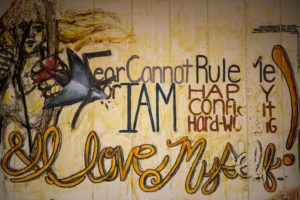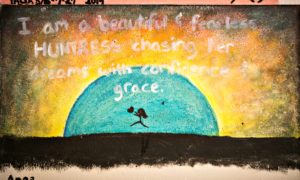In this four part series, Janna Pate explores the Rites of Passage work at Pacific Quest. From “Huli Ka’e,” the Rites of Passage experience that students participate in, to the “Staff Vision Fast,” a unique opportunity for staff to gain personal and professional development and a deeper understanding of this important component of the Pacific Quest curriculum. Read Part I of the series here.
By: Janna Pate, Academic Coordinator
One thing that I have cultivated at Pacific Quest, one thing that has stayed with me, and grown with me, is my Intent Statement. From the moment I stepped through the doors of Pacific Quest, from the moment I saw the Intent Statements of former Pacific Quest students tattooed on the walls, I knew that I wanted to write one, even when the question was still “one what?”

When I began working at Pacific Quest, I was lucky enough to be placed in the Huli Ka’e stage of the program. (“Huli Ka’e” means “to search the edge,” roughly translated from Hawaiian.) This is the most intensive Rites of Passage experience that we offer to students. Before going on Huli Ka’e, students are asked to spend time preparing for the journey. Part of the preparation involves crafting an Intent Statement.
These are the Intent Statement guidelines given to students:
- Your intent is a statement about the most important things for you to claim about yourself right now.
- Your intent will change over time, as the circumstances and challenges of your life change.
- Your intent should feel risky.
- Your intent, while something that you are always working toward, is also something you already know you are, inherently, at your core. Your intent highlights aspects of your best self that you are ready for the world to see.
- Your intent should be direct and to the point. It is the essence of you.
- You do not have to feel like your intent is attainable all the time. Sometimes it will feel very far away, buried once again under all of the challenges of life. However, it is something that you can always return to, an anchor that reminds you of who you are.
It was with these same guidelines in mind that I began trying to craft my own Intent Statement. For almost a year, I tinkered with my statement. I also began applying for the Staff Vision Fast.
This vision fast, led by experienced, internationally-respected guides, is a truly amazing, all-expenses-paid opportunity for a small group of Pacific Quest staff each year, and I definitely wanted to be among them.
 To me, the Staff Vision Fast is an opportunity to experience what our students experience, to put ourselves in their shoes, and to prove to ourselves that our program is powerful, worthwhile, and effective. It is an opportunity to experience the integrity of our program.
To me, the Staff Vision Fast is an opportunity to experience what our students experience, to put ourselves in their shoes, and to prove to ourselves that our program is powerful, worthwhile, and effective. It is an opportunity to experience the integrity of our program.
Most staff at Pacific Quest seem to be equally enthusiastic about the fast because there are always more applicants than spots, and almost no one gets selected on the first try. My first application was no exception. When my second application was accepted, I began the necessary preparations. As with students going on Huli Ka’e, one of the main things I had to do to prepare for the Staff Vision Fast was to draft my Intent Statement. Even though I had been working on my intent for a nearly year already, I knew that I had more work to do, writing draft after draft in my journal.
Check back next week for Part III!
The Intent Council Door: Part II
In this four part series, Janna Pate explores the Rites of Passage work at Pacific Quest. From “Huli Ka’e,” the Rites of Passage experience that students participate in, to the “Staff Vision Fast,” a unique opportunity for staff to gain personal and professional development and a deeper understanding of this important component of the Pacific …
In this four part series, Janna Pate explores the Rites of Passage work at Pacific Quest. From “Huli Ka’e,” the Rites of Passage experience that students participate in, to the “Staff Vision Fast,” a unique opportunity for staff to gain personal and professional development and a deeper understanding of this important component of the Pacific Quest curriculum. Read Part I of the series here.
By: Janna Pate, Academic Coordinator
One thing that I have cultivated at Pacific Quest, one thing that has stayed with me, and grown with me, is my Intent Statement. From the moment I stepped through the doors of Pacific Quest, from the moment I saw the Intent Statements of former Pacific Quest students tattooed on the walls, I knew that I wanted to write one, even when the question was still “one what?”
When I began working at Pacific Quest, I was lucky enough to be placed in the Huli Ka’e stage of the program. (“Huli Ka’e” means “to search the edge,” roughly translated from Hawaiian.) This is the most intensive Rites of Passage experience that we offer to students. Before going on Huli Ka’e, students are asked to spend time preparing for the journey. Part of the preparation involves crafting an Intent Statement.
These are the Intent Statement guidelines given to students:
It was with these same guidelines in mind that I began trying to craft my own Intent Statement. For almost a year, I tinkered with my statement. I also began applying for the Staff Vision Fast.
This vision fast, led by experienced, internationally-respected guides, is a truly amazing, all-expenses-paid opportunity for a small group of Pacific Quest staff each year, and I definitely wanted to be among them.
Most staff at Pacific Quest seem to be equally enthusiastic about the fast because there are always more applicants than spots, and almost no one gets selected on the first try. My first application was no exception. When my second application was accepted, I began the necessary preparations. As with students going on Huli Ka’e, one of the main things I had to do to prepare for the Staff Vision Fast was to draft my Intent Statement. Even though I had been working on my intent for a nearly year already, I knew that I had more work to do, writing draft after draft in my journal.
Check back next week for Part III!
Questions? Call or Text our Admissions Team: 808-937-5806